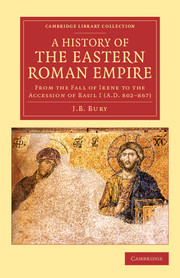Description
A History of the Eastern Roman Empire
From the Fall of Irene to the Accession of Basil I (A.D. 802–867)
Cambridge Library Collection - Medieval History Series
Author: Bury J. B.
This 1912 work argues that the 'Amorian epoch' of the ninth century should not be overlooked in Byzantine history.
Language: English
Subject for A History of the Eastern Roman Empire:
Approximative price 52.22 €
In Print (Delivery period: 14 days).
Add to cart
Publication date: 03-2015
Support: Print on demand
Support: Print on demand
Description
/li>Contents
/li>
The classical historian J. B. Bury (1861?1927) was the author of a history of Greece which was a standard textbook for over a century. He also wrote on the later history of the Roman empire, and, in this 1912 work, examines the Byzantine empire in the ninth century. The book is a continuation of his two-volume History of the Later Roman Empire of 1889, which covers the period from 395 to 800 (and is also reissued in this series), and reflects Bury's belief that the century-long so-called Amorian epoch 'is not a mere epilogue, and is much more than a prologue' between the better-known periods of Byzantine history that preceded and followed it. In this period, iconoclasm again became a cause of civil strife, and wars on the eastern frontier were a strain on the military resources of the empire, while at least two of the emperors were murdered.
1. Nicephorus I, Stauracius, and Michael I (AD 801–813); 2. Leo V, the Armenian, and the revival of iconoclasm (AD 813–820); 3. Michael II, the Amorian (AD 820–829); 4. Theophilus (AD 829–842); 5. Michael III (AD 842–867); 6. Photius and Ignatius; 7. Financial and military administration; 8. The Saracen wars; 9. The Saracen conquests of Crete and Sicily; 10. Relations with the western empire. Venice; 11. Bulgaria; 12. The conversion of Slavs and Bulgarians; 13. The empire of the Khazars and the peoples of the north; 14. Art, learning, and education in the Amorian period; Appendices; Bibliography; Index.
© 2024 LAVOISIER S.A.S.




